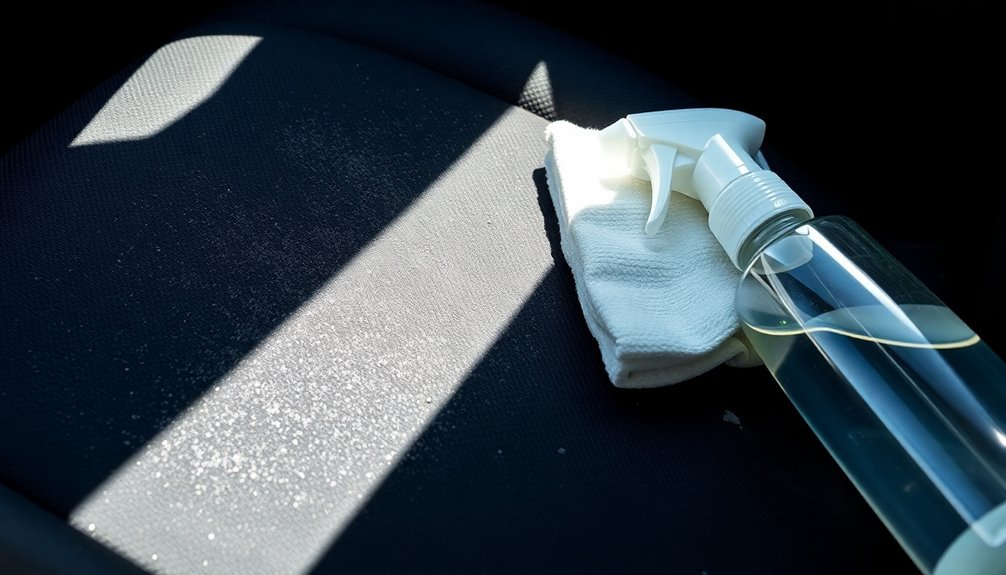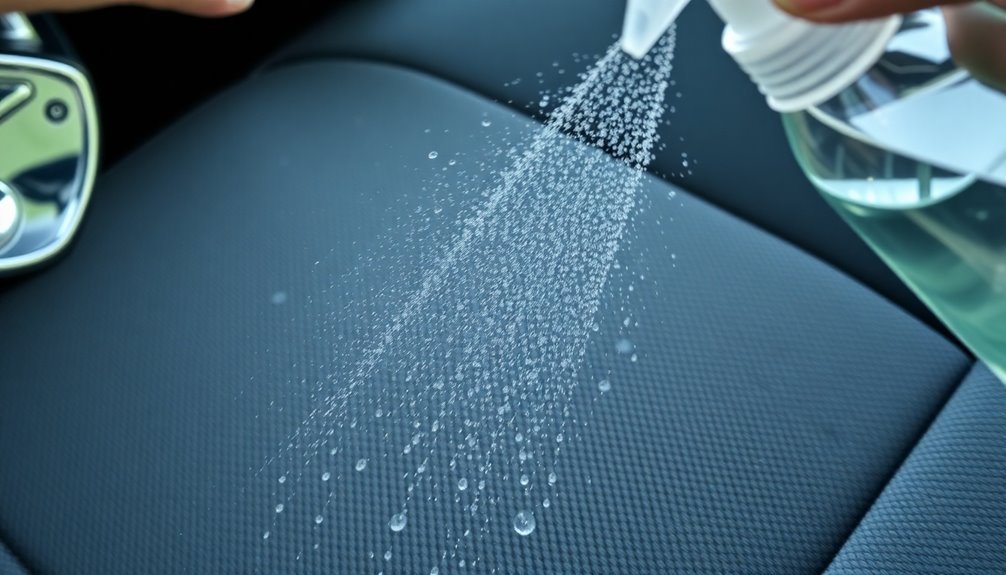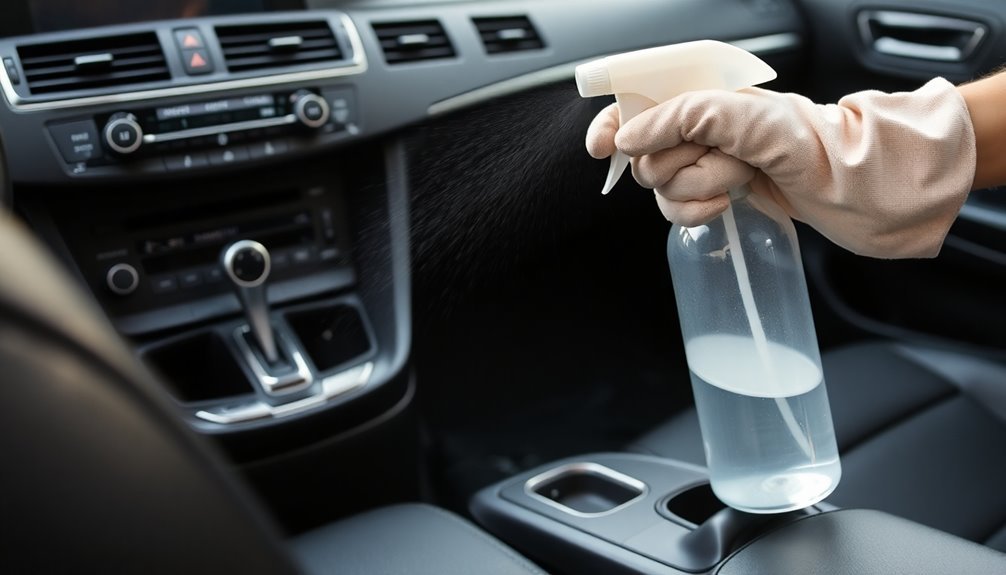You can create an effective DIY anti-static treatment for your car's interior using a simple 50/50 mixture of water and liquid fabric softener in a spray bottle. Before applying, clean all surfaces thoroughly and test the solution on a small, hidden area first. Apply the mixture to a microfiber cloth rather than spraying directly onto surfaces, then wipe down seats, dashboard, and other interior components. For best results, reapply every 1-2 months during regular use. You can also prevent static buildup by maintaining contact with metal parts while entering or exiting your vehicle. There's much more to learn about keeping your car static-free.
Understanding Static Electricity in Cars

Static electricity in your car isn't just a minor annoyance – it's a common phenomenon that occurs through several everyday actions. When you move around in your car seat or slide in and out of your vehicle, you're creating friction between your clothing and the upholstery. This movement causes electrons to transfer, building up a negative charge in your body.
Your car's tires also play a role in static buildup. As they roll along the road, they accumulate electrical charges that transfer to your car's body. Materials like polyester and wool in your clothing can significantly increase static generation while driving.
This effect becomes more pronounced during dry weather or winter months when humidity levels are lower, making it easier for static charges to accumulate rather than dissipate into the air.
Understanding how static builds up can help you prevent those unexpected shocks. When you exit your vehicle with a static charge, you'll feel a shock when touching metal parts because the electrons are suddenly transferring from your body to the metal surface, seeking to ground themselves.
This discharge happens more frequently in certain conditions, particularly in cold, dry weather when the air's moisture content is low.
Essential Anti-Static Products
Several effective anti-static sprays are available for your car's interior, including popular options like Chemical Guys Inner Clean and STEK Formula 01, which both offer excellent dust-repelling properties.
You'll find advanced SiO2-based detail sprays that provide longer-lasting protection while creating an invisible barrier against static buildup. The one-step cleaner protectant makes application quick and efficient for busy car owners.
For a more permanent solution, consider masterbatch additive treatments that can be integrated into your car's interior materials during the cleaning process, offering extended anti-static protection.
Popular Anti-Static Spray Options
Leading the market in anti-static treatment for car interiors are five popular spray products: STEK Formula 01 Interior, Chemical Guys Inner Clean, Ethos Interior Detailer Spray, Meguiar's Quik Interior Detailer, and Nextzett Cockpit Premium. These products offer varying features to help you maintain a dust-free interior while protecting your surfaces. STEK Formula 01's specialized formula provides intensive disinfection power while maintaining the original finish of your surfaces.
| Product Feature | Benefits |
|---|---|
| UV Protection | STEK, Chemical Guys, and Ethos provide UV blocking to prevent interior fading |
| Residue-Free | You'll get streak-free results with STEK and Chemical Guys formulas |
| Surface Versatility | Chemical Guys and Ethos work safely on multiple interior materials |
You'll find eco-friendly options like STEK Formula 01, while Ethos offers a silicone-free formula perfect for professional detailing. If you're interested in scented options, Chemical Guys provides pleasant variants including pineapple and baby powder. For thorough protection, these sprays don't just repel dust – they're designed for one-step cleaning and protection of your car's interior surfaces. Regular application of these products will help maintain a cleaner, dust-resistant environment in your vehicle, reducing the frequency of interior cleaning sessions.
SiO2-Based Detail Sprays
Technology in automotive detailing has advanced substantially with SiO2-based detail sprays emerging as powerful anti-static solutions. These innovative products contain silica dioxide particles that create a hydrophobic protective layer on your car's surfaces, effectively reducing static electricity buildup while offering superior protection compared to traditional polymer sprays.
When you're dealing with static in your car's interior, you'll find that SiO2 sprays are versatile enough to use on multiple surfaces, including plastic trim, glass, and upholstery. They're particularly effective because they not only combat static but also provide UV protection and enhance the surface's appearance with a glossy finish. The streak-free formula ensures flawless application every time.
To apply an SiO2 detail spray, you'll need to guarantee the surface is clean and cool. Spray the product onto a slightly damp microfiber towel – this helps prevent static buildup during application.
Work the product evenly across the surface, then use a dry microfiber towel to buff away any residue. You'll notice that these sprays create a water-beading effect that helps keep surfaces cleaner longer.
If you have ceramic-coated surfaces, don't worry – SiO2 sprays are typically safe to use and can even help extend the coating's life.
Masterbatch Additive Solutions
While SiO2 sprays offer immediate anti-static protection, masterbatch additives represent a more permanent solution for your car's interior components. These specialized additives can be integrated into your car's plastic components during manufacturing, providing long-lasting static protection that won't wear off like temporary treatments. This process helps prevent potentially dangerous static-induced sparks in areas where flammable materials might be present.
You'll find two main types of masterbatch solutions for your car's interior: migratory and non-migratory additives. Migratory additives work by forming a protective layer that captures moisture to dissipate static, while non-migratory versions provide consistent protection regardless of humidity levels.
For ideal results, you'll want components treated with a 3-5% masterbatch concentration.
When selecting replacement interior parts, look for those manufactured with anti-static masterbatch additives. These components will typically have a surface resistance of 10^7-10^11 ohms, effectively preventing static buildup while reducing dust attraction. They're particularly valuable for electronic-heavy areas like your dashboard and center console.
The best part? These treated components comply with automotive safety standards and maintain their anti-static properties throughout their lifetime, even in low humidity conditions.
Preparation Before Treatment

Prior to starting any anti-static treatment on your car's interior, proper preparation guarantees the best results and prevents potential damage.
You'll need to start by thoroughly vacuuming all interior surfaces to remove loose dirt and debris, then clear out any personal items or trash from the vehicle. Remove crumbs and dust with a microfiber cleaning cloth for best results.
Protect sensitive areas like electronics and delicate surfaces by covering them with protective materials or tape. Use a soft brush to gently dust surfaces, followed by compressed air to remove particles from tight spaces and crevices.
Before proceeding, inspect the interior thoroughly to identify stubborn stains and assess different material types present.
Gather your essential tools: microfiber cloths, detailing brushes, compressed air, your DIY anti-static solution, and protective gloves. Don't forget to test the solution on a hidden area first to confirm it won't damage the materials.
Confirm you're working in a well-ventilated area to prevent fume buildup. Read all chemical labels carefully and avoid over-saturating surfaces with cleaning solutions.
Pay special attention to high-traffic areas that show signs of wear and tear, as these spots may need extra care during treatment.
Safe Application Techniques
Mastering safe application techniques guarantees your DIY anti-static treatment will be effective and won't damage your car's interior surfaces. Start by selecting a high-quality, silicone-free product with UV blocking agents and anti-static additives to secure the best results for your vehicle's surfaces.
Regular treatment is essential since static electricity charges build up through surface friction during normal vehicle use. When applying the treatment, use a spray-and-wipe method with a microfiber cloth to avoid leaving streaks or fabric residue. Before treating the entire surface, test the product on a small, hidden area to confirm compatibility.
Don't oversaturate surfaces, as this can lead to residue buildup or potential damage. Always work in a well-ventilated area and wear protective gloves to prevent skin irritation. Keep the product away from sensitive electronics, and follow the manufacturer's instructions carefully.
You'll need to reapply the treatment periodically, as anti-static properties typically last several months to a year.
For best results, incorporate anti-static treatment into your regular maintenance routine. This will help maintain the interior's appearance while reducing dust accumulation over time. Remember that high-quality products may cost more initially but will provide longer-lasting protection for your car's interior surfaces.
Problem Areas and Solutions

Your car's most static-prone areas include the dashboard, seats, and center console, which require specific attention to prevent dust buildup.
You'll want to focus on these surfaces with anti-static treatments, applying products like STEK Formula 01 Interior or a DIY fabric softener solution to reduce static charges. The treatment creates a surface that is pleasant to smell, making your car's interior more enjoyable.
Regular maintenance of these problem areas with microfiber towels and appropriate anti-static products will keep your interior looking clean while preventing the constant attraction of dust and debris.
Dashboard Static Control
Static electricity plagues car dashboards, causing frustrating dust buildup and unexpected shocks when you touch metal surfaces. Your dashboard's plastic materials generate static charges through regular contact with clothing and other surfaces, making it a magnet for dust and difficult to maintain.
You can combat these issues with several effective solutions. Apply anti-static sprays specifically designed for automotive use to reduce electrical charges on your dashboard.
Consider using specialized products like collinite insulator wax, which helps eliminate static shocks while providing protection.
When you're exiting your vehicle, make it a habit to hold onto metal parts to safely discharge any built-up static electricity.
For proper maintenance, you'll need to use anti-static cleaners rather than regular cleaning products, which may not address the static problem. Regular cleaning with these specialized products prevents dust accumulation and reduces shock risks.
You can also implement preventive measures by applying anti-static treatments to your dashboard surfaces and conducting regular inspections to catch static-related issues early.
If you're still experiencing problems, consider using static neutralizing products specifically designed for automotive interiors.
Seat Material Protection
Car seats present unique challenges when it comes to static electricity control. Common problem areas include seats made from static-prone materials like polyester and nylon, especially during cold winter months in dry climates.
You'll notice increased static buildup when you're wearing synthetic fabrics or frequently touching metal parts of your vehicle.
To combat these issues, you've got several effective DIY solutions at your disposal. You can create a white distilled vinegar spray to dispel static electricity while eliminating odors, or use a diluted fabric softener solution that'll reduce static cling and add freshness.
If you're looking for a more permanent solution, consider installing grounding straps or switching to seat covers made from natural fibers like cotton or wool.
For enhanced protection, you might want to try using space blankets with their aluminized sides as seat covers, connecting them to proper grounding systems. Don't forget to test the conductivity with a multimeter to verify effectiveness.
You can also opt for professional treatments like Crystal Fusion Interior Treatment, which creates a hydrophobic barrier that not only prevents static buildup but also protects your seats from stains and liquids.
Center Console Maintenance
Modern center consoles demand regular attention due to their complex mix of electronic components and high-touch surfaces. You'll need to focus on both cleaning and preventive maintenance to keep your console functioning properly and looking its best.
Start by using detailing brushes to clean tight spaces around buttons and dials, removing accumulated dirt and sticky residue. Apply an interior detailer and protectant to maintain the surfaces while preventing premature wear.
For deeper cleaning, you can use a steam cleaner to sanitize and eliminate bacteria and mold in hard-to-reach areas.
Watch for common issues like power loss, which often stems from loose fuse box connections in the passenger footwell. If you experience problems with climate control or infotainment systems, check fuses 60-69.
You can reset troubled systems by disconnecting the battery's positive terminal for 10 minutes. Pay attention to unusual sounds like knocking from blend door motors or clicking relays, as these may indicate developing problems.
Regular maintenance should include inspecting for water ingress, particularly around the rear camera area, and checking sensor functionality. If you encounter persistent issues, don't hesitate to consult a professional mechanic for complex electrical problems.
Maintenance and Reapplication Schedule
Maintaining an effective anti-static treatment in your vehicle requires a consistent reapplication schedule that varies based on usage patterns and environmental conditions. You'll need to adapt your maintenance routine according to how frequently you use your car and the local climate.
For the best protection against static buildup in your car's interior, follow these key reapplication guidelines:
- Apply anti-static spray to fabric surfaces like seats and floor mats every 1-2 months if you use your car daily, or every 2-4 months for occasional use.
- Treat your center console and dashboard surfaces every 2-3 days if you frequently interact with these areas, or weekly for moderate use.
- Spray electronic components and displays weekly, focusing on touchscreens and control panels that see regular contact.
- Reapply treatment to carpeted areas monthly during dry seasons, adjusting frequency based on local humidity levels.
Test the effectiveness of your anti-static treatment monthly by checking for static buildup on various surfaces. If you notice increased static charge before your scheduled reapplication, treat the affected areas immediately.
Always apply the spray in a well-ventilated space and test on an inconspicuous area first.
Common Mistakes to Avoid

During DIY anti-static treatments, several common mistakes can undermine your efforts and potentially damage your car's interior surfaces.
One critical error is spraying cleaning products directly onto sensitive areas like your instrument cluster, which can cause severe damage, especially in hot conditions.
You'll also want to avoid using household cleaners containing ammonia, as these can dry out and discolor your interior materials.
Don't make the mistake of applying oil-based dressings to your interior surfaces. These products create hazardous conditions when used on steering wheels and pedals, and they'll attract dust while leaving behind greasy residues. They can also gas out, creating a dangerous haze on your windshield that obstructs vision.
Before applying any anti-static treatment, make certain you've properly cleaned the surface first. Skipping this step leads to poor product adhesion and uneven results.
Always follow product instructions carefully, and don't over-apply – using too much product will attract more dust and create residue buildup.
Remember to remove old treatments completely before applying new ones to prevent product accumulation and maintain effective static control.
Frequently Asked Questions
Can Anti-Static Treatments Affect Electronic Components or Sensors in Modern Vehicles?
When properly used, anti-static treatments won't harm your vehicle's electronics. However, you'll want to avoid direct application to sensors or components, and stick to manufacturer-approved products to guarantee your car's safety.
Will Anti-Static Treatments Change the Texture or Appearance of Leather Seats?
You don't need to worry – anti-static treatments won't change your leather seats' texture or appearance. They'll preserve the factory finish while keeping the leather looking natural, without leaving any slick or greasy residue.
Do Air Conditioning Settings Impact the Effectiveness of Anti-Static Treatments?
Yes, your air conditioning settings substantially affect anti-static treatments. Running your AC with high humidity levels helps maintain effectiveness, while low humidity can reduce the treatment's performance and require more frequent reapplication.
Should Anti-Static Products Be Avoided During Specific Weather Conditions?
You shouldn't avoid anti-static products in any weather, but they're most effective in dry, cold conditions. During high humidity, you won't need them as much since moisture naturally helps dissipate static electricity.
Can Anti-Static Treatments Interfere With Built-In Seat Heating or Cooling Functions?
While there's no direct evidence that anti-static treatments interfere with seat heating or cooling, you'll want to apply them sparingly and avoid direct contact with electronic components. Test a small area first to verify compatibility.
In Summary
You've now learned how to combat static electricity in your car using simple DIY methods. Remember to regularly mist surfaces with anti-static spray, focus on problem areas like seats and carpets, and avoid over-application. Keep your car's humidity balanced and reapply treatments every 3-4 months. By following these steps, you'll enjoy a static-free driving experience while protecting your vehicle's electronic components.





Leave a Reply